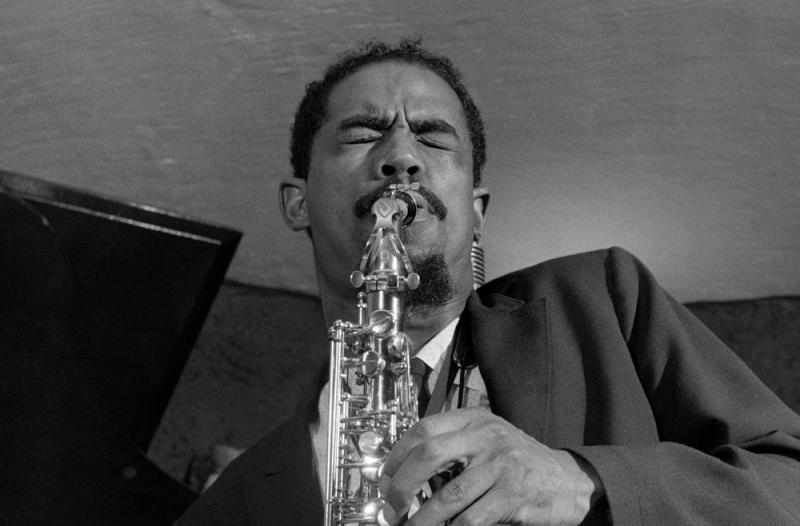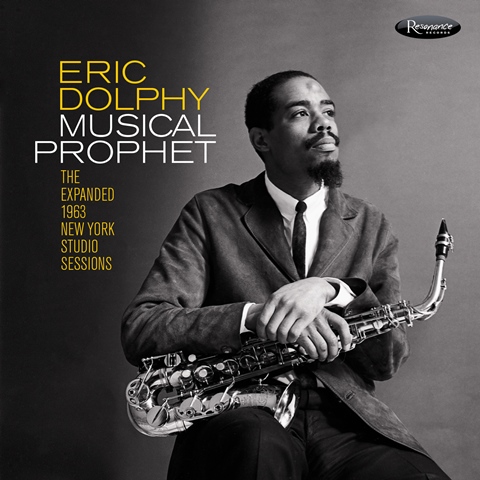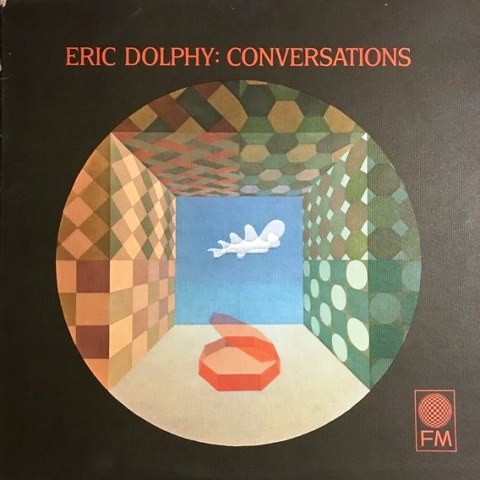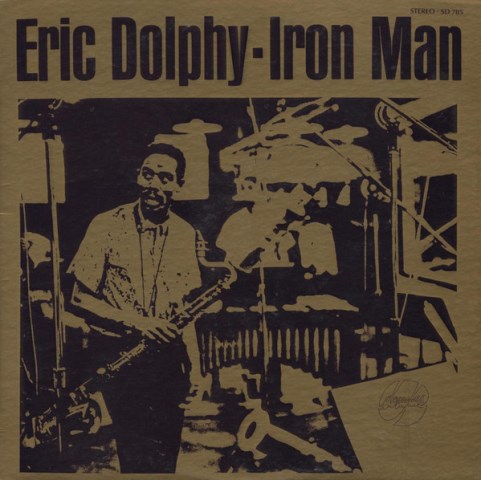Reissue CDs Weekly: Eric Dolphy | reviews, news & interviews
Reissue CDs Weekly: Eric Dolphy
Reissue CDs Weekly: Eric Dolphy
'Musical Prophet': diligent reconfiguration of the 1963 recordings with Alan Douglas

The tapes from which Musical Prophet: The Expanded 1963 New York Studio Sessions is sourced were found in a suitcase Eric Dolphy had given to musical polymath Hale Smith and his wife Juanita before setting off on a European tour in 1964. What was handed over by the prodigious multi-instrumentalist for safekeeping has never before been fully explored by an archive release.
Musical Prophet, then, is freighted with meaning. It represents a series of recordings which were important to Dolphy himself. However, it is clear there was more than one copy of what was on the tapes stored in the case. The material on this new release is essentially an augmented reissue of the albums Conversations and Iron Man. Conversations was issued in 1963 and Iron Man came out in 1968, four years after Dolphy’s death. The material on both albums was recorded by producer Alan Douglas on 1 and 3 July 1963 in New York. According to Musical Prophet’s liner notes, the Douglas estate does not have the tapes. Even so, Douglas must have had a copy of at least some of the material at some point after Dolphy’s death as otherwise he would have been unable to issue Iron Man.
 One aspect of where Musical Prophet goes much further than Douglas is by issuing the tapes in mono. Conversations was released in mono and stereo in 1963, while Iron Man was stereo only. The tapes Dolphy had kept were not rechanneled. Furthermore, going through these masters has found previously unissued material. While Disc One includes all of Conversations and what Douglas assembled as Iron Man is on Disc Two, each disc contains bonus tracks from the sessions. There is a further disc of alternate versions. “A Personal Statement”, a 2 March 1964 recording which was first issued on CD in 1987, is also included – the tape was also in the suitcase. Musical Prophet is issued on CD and vinyl, but the latter was not supplied for review and is not addressed here.
One aspect of where Musical Prophet goes much further than Douglas is by issuing the tapes in mono. Conversations was released in mono and stereo in 1963, while Iron Man was stereo only. The tapes Dolphy had kept were not rechanneled. Furthermore, going through these masters has found previously unissued material. While Disc One includes all of Conversations and what Douglas assembled as Iron Man is on Disc Two, each disc contains bonus tracks from the sessions. There is a further disc of alternate versions. “A Personal Statement”, a 2 March 1964 recording which was first issued on CD in 1987, is also included – the tape was also in the suitcase. Musical Prophet is issued on CD and vinyl, but the latter was not supplied for review and is not addressed here.
At the point Dolphy recorded with Douglas, his hook-up with Blue Note records was just-over nine months off. The first album for the circumstances-curtailed deal was 1964’s Out to Lunch! album. Dolphy’s catalogue up to his death was hard to get a handle on. Multiple imprints had issued albums credited to him: some as the sole artist, and others as a band-member or sideman. Following his passing, it became even messier. Amongst this jumble, Douglas reissued Conversations as The Eric Dolphy Memorial Album in 1965 and then conceived Iron Man, the more rough-edged of the two albums.
 Any new release seeking to impose order on Dolphy’s catalogue is welcome. One which does so with care and diligence even more so, especially when the material has previously been mined by bootleggers. Musical Prophet sounds extraordinary. A comparison with a scuffed first pressing of a mono Conversations suggests the original album was overly compressed. The new mastering sorts out this muzziness and also brings every instrument to the fore with a hitherto lacking crispness. Clearly, as can be heard, there was nothing wrong with Douglas’ work in the studio but an adverse sonic transformation had taken place during 1963’s leap from master tape to vinyl.
Any new release seeking to impose order on Dolphy’s catalogue is welcome. One which does so with care and diligence even more so, especially when the material has previously been mined by bootleggers. Musical Prophet sounds extraordinary. A comparison with a scuffed first pressing of a mono Conversations suggests the original album was overly compressed. The new mastering sorts out this muzziness and also brings every instrument to the fore with a hitherto lacking crispness. Clearly, as can be heard, there was nothing wrong with Douglas’ work in the studio but an adverse sonic transformation had taken place during 1963’s leap from master tape to vinyl.
Despite the sonic upgrade, the arresting unreleased material is Musical Prophet's draw. There are alternate takes of Conversations’ four tracks: “Jitterbug Waltz”, “Music Matador”, “Love Me” and “Alone Together” – two of “Love Me” and one apiece for the others. The only alternates from Iron Man are “Burning Spear” and “Mandrake”. There are also two previously unheard takes of “Muses for Richard Davis” (named for its bass player), an interplay driven work-out which didn’t crop up on the two Sixties albums.
 One of Musical Prophet’s joys is being able to resequence the new tracks to construct an alternate, prototypical Conversations: one punchier, and even more musically discursive and spiralling than the original album. Jump in with the new version of “Alone Together”. These, though, are try-outs for what was issued and familiar intros are missing and there are sudden halts in the playing. Performing such a reconfiguration with Iron Man isn’t possible as there aren’t enough alternates to make a fresh take on the album. Even if there were, doing so would be pointless as Douglas was exploiting then-unissued material from his own archives rather than issuing what had been intended as an album proper which was then shelved.
One of Musical Prophet’s joys is being able to resequence the new tracks to construct an alternate, prototypical Conversations: one punchier, and even more musically discursive and spiralling than the original album. Jump in with the new version of “Alone Together”. These, though, are try-outs for what was issued and familiar intros are missing and there are sudden halts in the playing. Performing such a reconfiguration with Iron Man isn’t possible as there aren’t enough alternates to make a fresh take on the album. Even if there were, doing so would be pointless as Douglas was exploiting then-unissued material from his own archives rather than issuing what had been intended as an album proper which was then shelved.
In addition to being well conceived and well designed, the Musical Prophet package includes a fat booklet with great photos and copious liner notes – about half of the text focuses on the material on the discs and the context of the period when it was recorded. Generalised tributes to Dolphy from Ornette Coleman, Charles Mingus, McCoy Tyner and more (given in various periods), reminiscences of Douglas by Bill Laswell and Michaël Lemesre, and one of Dolphy by Sonny Rollins are less germane to the contents. The booklet edges towards coming across as a Dolphy tribute publication rather than something fully engaging with what is being heard. The annotation does not say whether there is more unissued material. And, does “A Personal Statement” really belong on a Musical Prophet? It has nothing to do with the "1963 New York Studio Sessions".
Nonetheless, deep knowledge of and an affection for what it is being dealt with has fed into Musical Prophet. This is balanced against an inherent conscientiousness. Were it thus for all packages like this.
- Next week: 40th-anniversary reissue of Sparks’ No.1 In Heaven
- Read more reissue reviews on theartsdesk
- Kieron Tyler’s website
Explore topics
Share this article
The future of Arts Journalism
You can stop theartsdesk.com closing!
We urgently need financing to survive. Our fundraising drive has thus far raised £49,000 but we need to reach £100,000 or we will be forced to close. Please contribute here: https://gofund.me/c3f6033d
And if you can forward this information to anyone who might assist, we’d be grateful.

Subscribe to theartsdesk.com
Thank you for continuing to read our work on theartsdesk.com. For unlimited access to every article in its entirety, including our archive of more than 15,000 pieces, we're asking for £5 per month or £40 per year. We feel it's a very good deal, and hope you do too.
To take a subscription now simply click here.
And if you're looking for that extra gift for a friend or family member, why not treat them to a theartsdesk.com gift subscription?
more New music
 Music Reissues Weekly: Sly and the Family Stone - The First Family: Live At Winchester Cathedral 1967
Must-have, first-ever release of the earliest document of the legendary soul outfit
Music Reissues Weekly: Sly and the Family Stone - The First Family: Live At Winchester Cathedral 1967
Must-have, first-ever release of the earliest document of the legendary soul outfit
 Album: Robert Plant - Saving Grace
Mellow delight from former Zep lead
Album: Robert Plant - Saving Grace
Mellow delight from former Zep lead
 Brìghde Chaimbeul, Round Chapel review - enchantment in East London
Inscrutable purveyor of experimental Celtic music summons creepiness and intensity
Brìghde Chaimbeul, Round Chapel review - enchantment in East London
Inscrutable purveyor of experimental Celtic music summons creepiness and intensity
 Album: NewDad - Altar
The hard-gigging trio yearns for old Ireland – and blasts music biz exploitation
Album: NewDad - Altar
The hard-gigging trio yearns for old Ireland – and blasts music biz exploitation
 First Person: Musician ALA.NI on how thoughts of empire and reparation influenced a song
She usually sings about affairs of the heart - 'TIEF' is different, explains the star
First Person: Musician ALA.NI on how thoughts of empire and reparation influenced a song
She usually sings about affairs of the heart - 'TIEF' is different, explains the star
 Album: The Divine Comedy - Rainy Sunday Afternoon
Neil Hannon takes stock, and the result will certainly keep his existing crowd happy
Album: The Divine Comedy - Rainy Sunday Afternoon
Neil Hannon takes stock, and the result will certainly keep his existing crowd happy
 Music Reissues Weekly: Robyn - Robyn 20th-Anniversary Edition
Landmark Swedish pop album hits shops one more time
Music Reissues Weekly: Robyn - Robyn 20th-Anniversary Edition
Landmark Swedish pop album hits shops one more time
 Album: Twenty One Pilots - Breach
Ohio mainstream superstar duo wrap up their 10 year narrative
Album: Twenty One Pilots - Breach
Ohio mainstream superstar duo wrap up their 10 year narrative
 Album: Ed Sheeran - Play
A mound of ear displeasure to add to the global superstar's already gigantic stockpile
Album: Ed Sheeran - Play
A mound of ear displeasure to add to the global superstar's already gigantic stockpile
 Album: Motion City Soundtrack - The Same Old Wasted Wonderful World
A solid return for the emo veterans
Album: Motion City Soundtrack - The Same Old Wasted Wonderful World
A solid return for the emo veterans
 Album: Baxter Dury - Allbarone
The don diversifies into disco
Album: Baxter Dury - Allbarone
The don diversifies into disco
 Album: Yasmine Hamdan - I Remember I Forget بنسى وبتذكر
Paris-based Lebanese electronica stylist reacts to current-day world affairs
Album: Yasmine Hamdan - I Remember I Forget بنسى وبتذكر
Paris-based Lebanese electronica stylist reacts to current-day world affairs

Add comment